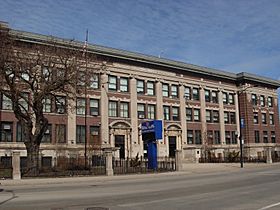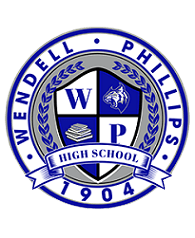Wendell Phillips Academy High School facts for kids
Quick facts for kids Wendell Phillips Academy High School |
|
|---|---|
 |
|
| Address | |
|
244 East Pershing Road
, 60653
United States
|
|
| Coordinates | 41°49′28″N 87°37′11″W / 41.82444°N 87.61972°W |
| Information | |
| School type | |
| Motto | "The Premiere South Side School of Choice." |
| Opened | September 4, 1904 |
| School district | Chicago Public Schools |
| CEEB code | 141375 |
| NCES School ID | 170993001061 |
| Principal | Rashad J. Talley |
| Grades | 9–12 |
| Gender | Coed |
| Enrollment | 394 (2024–2025) |
| Area | Urban |
| Color(s) | Blue White |
| Athletics conference | Chicago Public League |
| Team name | Wildcats |
| Accreditation | North Central Association of Colleges and Schools |
| Yearbook | Phillipsite |
 |
|
Wendell Phillips Academy High School is a public high school in the Bronzeville neighborhood of Chicago, Illinois. It opened in September 1904. Phillips is part of the Chicago Public Schools system. It is named after Wendell Phillips, an American abolitionist. This school was the first mainly African-American high school in Chicago. The school building became a Chicago Landmark on May 7, 2003.
Contents
A Look Back: Phillips High School's History
How Phillips High School Started
The school's story began in 1875 with South Division High School. This was the first public high school on Chicago's south side. In 1900, the Chicago Board of Education decided to build a new school. Community members wanted a more modern building. The new school was meant to replace South Division High School.
Construction on the new building started and was almost finished by 1903. However, work stopped for a few months due to labor issues. It started again in January 1904 and was done by May 1904. The building was designed in the Classical Revival style by architect William B. Mundie. Phillips High School officially opened for students on September 4, 1904. It was named after Wendell Phillips, who fought against slavery and for the rights of Native Americans.
Changes in Students Over Time
When Phillips opened in 1904, many wealthy children from Chicago's south side attended. But this soon changed. The Great Migration brought many African Americans from the rural South to northern cities like Chicago. By 1907, 90 Black students were at Phillips. Early school yearbooks show a mix of races. By 1920, Phillips became Chicago's first high school with mostly African-American students.
In 1924, a junior high school section was added within Phillips for seventh and eighth graders. By 1928, so many students attended that the school needed extra space. They used portable classrooms and had two half-day shifts for students.
New Buildings and Overcrowding
In 1929, the Board of Education planned a new school in Bronzeville. It was to be called The New Wendell Phillips High School. This was because the original Phillips was too crowded. The Great Depression slowed down building work. The new school was finally finished on February 4, 1935.
Just before the new building was ready, the original Phillips school had a fire on January 28, 1935. This meant students had to move to the new school in February 1935. The new school was later named Jean Baptiste Point DuSable High School in April 1936. At first, only sophomores, juniors, and seniors moved to the new building. Freshmen stayed at the undamaged part of Phillips.
A new section was built at the original Phillips site in late 1936. This new wing had an assembly hall, gym, swimming pool, and music rooms. It served as an elementary school after junior high schools were stopped in Chicago in 1933. In November 1937, some classrooms in this new wing caught fire before it was fully ready. Repairs were made.
During the 1940s, Phillips offered classes for adults, known as Evening School. The elementary part of the school also became very crowded. A 20-classroom addition was built in 1944. By the early 1960s, Phillips had about 2,200 students. Students attended classes in three shifts because of overcrowding. In 1979, the school started the Wendell Phillips High School Hall of Fame.
Who Has Led Phillips High School?
Here is a list of the principals who have led Wendell Phillips Academy High School since it opened in 1904:
- Spencer R. Smith (1904–1917)
- Charles H. Perrine (1917–1921)
- Albert W. Evans (1921–1926)
- Chauncey C. Willard (1926–1935)
- William H. Page (1935–1937)
- William Abrams (1937–1939)
- Maudelle B. Bousfield (1939–1950)
- Virginia F. Lewis (1950–1961)
- Robert E. Lewis (1961–1965)
- Alonzo A. Crim (1965–1968)
- William Finch (1968–1971)
- Daniel W. Caldwell (1971–1975)
- Ernestine D. Curry (1975–1990)
- Juanita T. Tucker (1990–1997)
- Beverly LaCoste (1997–2001)
- Bertha Buchanan (2002–2004)
- Euel Bunton (2004–2010)
- Terrence A. Little (2010)
- Devon Q. Horton (2010–2014)
- Matthew G. Sullivan (2014–2021)
- Virag C. Nanavati (2021–2022)
- Rashad J. Talley (2022–present)
More About Phillips High School
Phillips in Movies
Phillips High School was used as a filming location for the movie Save the Last Dance, which came out in 2001.
The Savoy Big Five: A Basketball Story
In the late 1920s, members of the school's successful basketball team were chosen by Abe Saperstein. They formed a group that later became the famous Harlem Globetrotters. They were first called "The Savoy Big Five." This name came from Bronzeville's Savoy Ballroom. Some of these players included Tommy Brookings, Hillery Brown, George Easter, William "Razor" Frazier, Roosevelt Hudson, Inman "Big Jack" Jackson, Lester Johnson, Byron "Fat" Long, William "Kid" Oliver, Al "Runt" Pullins, Randolph Ramsey, Ted Strong, and Walter "Toots" Wright.
Learning at Phillips High School
What Classes Does Phillips Offer?
Phillips is a High School Transformation and Advancement Via Individual Determination (AVID) school. It offers Advanced Placement (AP) courses and honors courses. These classes help students learn in a positive way. They focus on reading, writing, and asking questions. AP courses are available in U.S. history, Biology, and English. Honors courses are offered in 15 different subjects.
The school also has "Education To Careers" (ETC) programs. These programs teach skills in fashion design, graphic communications, and drafting. Phillips also has a Junior Air Force Reserve Officers Training Corps (JAFROTC) program. There is also a health clinic to help students. Students living in the school's area can enroll. If there is space, students from other areas can also apply.
Fun Activities and Clubs
Besides sports, Phillips offers many activities. Students can join the Student Council, Air Force (AFJROTC), a school Newspaper Club, the Book Club, and the Culture Club. There is also a Music Production Project, an Entrepreneurial Project, Junior Achievement, the yearbook, and a debate team.
Working with the Community
Phillips works with many community and university partners. These include the University of Chicago, Illinois Institute of Technology, and the Field Museum. In 2010, Phillips became a "turnaround" school. This was done to help lower the number of students who dropped out. In 2013, the school won an award for its use of technology. The school's attendance area includes parts of the South Side, Chinatown, and the Chicago Loop.
Sports at Phillips High School
Phillips competes in the Chicago Public League (CPL). It is also a member of the Illinois High School Association (IHSA). The school's sports teams are called the Wildcats. Phillips teams have a history of being very successful.
The boys' basketball team won the state Class AA title in 1974–75. They were also city champions in Chicago in 1976. The boys' track and field team won first place in 1901–02, 1905–06, 1942–43, 1949–50, 1950–51, and 1961–62.
The girls' basketball team won regional championships in 2012–13. The 2014–15 Wildcats football team was the IHSA class 4A runner-up. They were the second Chicago Public Schools team to play in an IHSA football championship game. In the 2015–16 season, Phillips returned to the 4A finals. They defeated Belleville Althoff 51–7. This made them the first Chicago public league team to win a state championship in football. They won again in 2017 in the 5A division, beating Dunlap 33–7.
Famous People Who Attended Phillips High School
Many notable people have attended Wendell Phillips Academy High School:
- Pastor T. L. Barrett — minister and gospel recording artist.
- Timuel Black — Historian and civil rights activist.
- Gwendolyn Brooks — author, first African American to win the Pulitzer Prize.
- Hillery Brown — professional basketball player.
- Archibald Carey, Jr (1926) — lawyer, judge, politician, and clergyman.
- Jodie Christian — jazz musician.
- Floy Clements — first Black woman to become a state legislator in Illinois.
- Darius Clemons (1978) — basketball player.
- Nat "King" Cole — singer, musician, and recording star in Rock and Roll Hall of Fame.
- Sam Cooke — Soul and gospel recording star in Rock and Roll Hall of Fame.
- Earl B. Dickerson — attorney and business executive.
- Osiris Eldridge (2006) — professional basketball player.
- Mary G. Evans — minister, who led Chicago's Cosmopolitan Community Church.
- Wilson Frost (1943) — politician, Chicago alderman.
- Marla Gibbs (1949) — Emmy Award-winning actress, singer and comedian (The Jeffersons, 227).
- Lucius Perry Gregg, Jr. — fourth African American to graduate from United States Naval Academy.
- Alvin Hall — former NFL player.
- Carl "Buster" Smith — former checkers player.
- Vivian G. Harsh (1909) — Librarian and historian, Chicago Public Library's first African American librarian.
- Bernie Hayes — broadcast journalist.
- Herbie Hancock — jazz musician.
- Chris Hinton — NFL player.
- Milt Hinton — jazz musician.
- Paul Des Jardien — member of College Football Hall of Fame.
- George E. Johnson, Sr. — businessman, founder of Johnson Products.
- John H. Johnson — founder of Johnson Publishing Company (Ebony, Jet).
- George Kirby — comedian, actor and singer.
- Gerri Major (1912) — journalist, editor and author.
- Billy Martin — former professional NFL halfback.
- Ira Murchison (1951) — sprinter, gold medalist at 1956 Olympic Games.
- Lee Roy Murphy — professional boxer.
- Larry Murray (1971) — MLB professional baseball player.
- Ray Nance — jazz trumpeter.
- Guy Ousley — Negro league shortstop.
- Alonzo S. Parham — second African American to attend West Point.
- Polo G – rapper.
- Mike Pruitt (1972) — NFL player.
- Al Pullins – original member of Harlem Globetrotters.
- Ted Double Duty Radcliffe (1920) — member of Baseball Hall of Fame.
- William Clintard "Bill" Robinzine (1971) — NBA basketball player.
- Charles Skyles — state legislator in Illinois.
- Dinah Washington — singer, recording artist in Rock and Roll Hall of Fame.
- Mary T. Washington — the first African-American woman CPA.
- Frances Cress Welsing — psychiatrist, author of The Isis Papers: The Keys to the Colors.
- Steven Williams — actor.
- Claude "Buddy" Young — Pro Football Hall of Famer, first African-American executive hired by a major sports league (NFL).
Notable Staff Members
Some important staff members at Phillips High School include:
- Maudelle B. Bousfield (1885–1971) — educator and school administrator. She was principal of Phillips from 1939 to 1950. She was the first African-American principal in a Chicago public school.
- Captain Walter Dyett (1901–1969) — violinist and assistant music instructor.
- Mildred Bryant Jones (1887–1966) — musician, educator, and the first African-American music director at Wendell Phillips.
- Geraldine McCullough (1917–2008) — sculptor and painter; she taught art.

